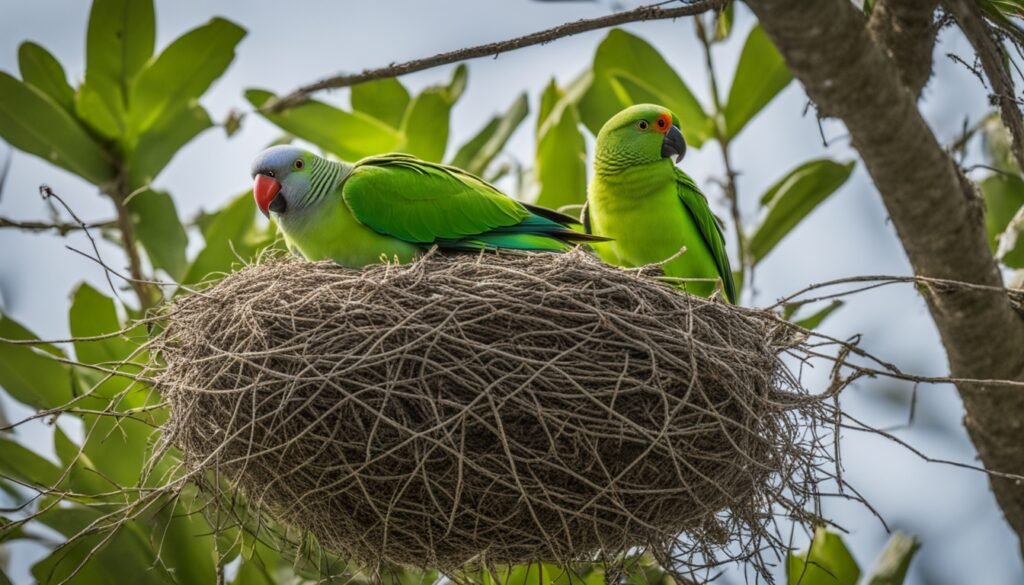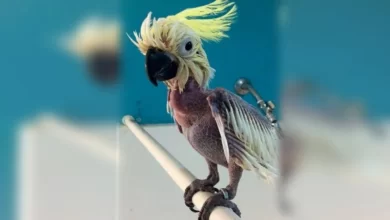Why is the monk parakeet a problem in Florida?
Ever thought about why the monk parakeet, once seen as harmless, is now a big issue in Florida? This bird has become an invasive species, causing problems for the state’s environment and economy. Let’s look into why the monk parakeet is a concern and how it affects Florida’s nature and people.
Invasive Species in Florida
Regulatory Status and Description
The monk parakeet, also known as the Quaker parakeet, is an invasive species in Florida. It was brought to the U.S. in the 1960s, both on purpose and by accident. Now, their numbers have grown a lot, causing problems for the environment and economy.
Monk parakeets are special because they build big nests from sticks and twigs. They often put these nests on things like power lines and cell towers. This lets them live well in Florida, where they don’t have many enemies or diseases.
In South Florida, most monk parakeet nests are on power equipment, other structures, or in trees. From 2001 to 2007, the number of nests on power substations went from 38 to 62. This shows how fast their population is growing.
| Nesting Location | Percentage |
|---|---|
| Electric utility equipment | 60% |
| Other man-made structures | 20% |
| Trees | 20% |
The monk parakeet’s behavior and nesting habits are causing big problems in Florida. Their nests can harm electrical systems, leading to power outages and higher costs. This has led to efforts to manage their population in the state.
Environmental Impact
The monk parakeet in Florida has raised concerns about its environmental impact. Its effects are not yet fully understood, but several areas need attention.
One worry is the competition it has with native wildlife for resources like nesting spots and food. As more monk parakeets arrive, they might push out native birds. This could upset the balance in the local ecosystem.
Also, the monk parakeet’s nesting behavior can harm tropical fruit crops like longans and mangos. This harm can hurt the local farming industry and make food less secure for people.
Another big issue is that monk parakeets like to nest on electric utility structures. This includes things like substations and poles. This can cause decreased reliability, equipment damage, and power outages. It makes electricity less reliable and costs more for utility companies and affects the community.
| Statistic | Impact |
|---|---|
| In southern Florida, 60% of monk parakeet nests were found on energized electric utility equipment. | Decreased reliability of electricity and damage to infrastructure are economic impacts resulting from monk parakeet nesting behaviors on electric utility facilities in Florida. |
| The number of substations with monk parakeet nests in southern Florida increased from 38 in 2001 to 62 in 2007. | This surge in nesting on utility infrastructure has led to significant power outages and repair costs for utility providers. |
| An estimated parakeet population of over 100 birds can be found in one substation. | The large population sizes of monk parakeets nesting on utility structures amplify the scale of the problem, posing challenges for effective management. |
The impact of monk parakeets on native wildlife in Florida is still being studied. Their ability to live in cities has raised worries about their effect on local ecosystems. As they grow in number, we need to keep watching and researching to understand their full impact.
Why is the monk parakeet a problem in Florida?
The monk parakeet, originally from South America, is now a big worry in Florida. It has made its home in cities and suburbs, growing in numbers with little to stop it. This colorful parrot causes problems for the local ecosystem and buildings.
One big issue is how it competes with native birds for homes and food. As more monk parakeets arrive, they push out and harm native birds. This upsets the balance of nature.
Another problem is how they affect Florida’s farms. These birds damage crops like fruits, veggies, and grains. This hurts farmers’ wallets and food production.
The biggest issue is the damage to important structures, like power lines and towers. Monk parakeets build big nests on these, causing power outages and repair costs. Managing these birds is hard for both nature and building upkeep.
The monk parakeet’s presence in Florida affects cities, farms, and important buildings. As their numbers grow, dealing with them will get harder. We need a strong plan to lessen the harm they cause.
Diet and Damage to Crops
Food Habits
The monk parakeet comes from South America and eats many things. They like seeds, fruits, blossoms, insects, and tree parts. In Florida, they eat sweet potatoes, legumes, and even cereal crops like maize and sorghum.
They also enjoy citrus fruits. While they don’t cause much damage in Florida, they do hurt tropical fruits like longans and mangos. In places like Argentina, they are a big problem for crops like sorghum, sunflower, and rice.
Monk parakeets change what they eat with the seasons. They eat native and introduced plants. Their ability to adapt and find food makes them a worry for farmers. Their numbers are growing, which is a concern.
It’s thought that monk parakeets can cause a lot of damage to crops. This can range from a little to a lot, depending on the situation.
Population and Distribution
The monk parakeet, an introduced species in Florida, has grown in numbers over the years. Recent data shows a big increase in their population. In the 2002/2003 Christmas Bird Count, 2,884 monk parakeets were found in 22 places across 16 Florida counties. This made up 69.4% of all monk parakeet sightings nationwide.
The monk parakeets in Florida are growing fast, with a growth rate of 0.094. This means their numbers double every 7.5 years. This growth has helped them spread across the state, especially in cities like Miami, West Palm Beach, and Tampa.
Monk parakeets love living in urban and suburban environments. They eat from backyard feeders and non-native plants. Their ability to live in different climates and places has helped them thrive in many areas.
The monk parakeets have spread widely in Florida’s urban environments. This shows how well they can grow and spread. As an introduced species, their growing numbers worry people about their effect on the environment and economy.
| Year | Monk Parakeet Population in Florida | Percentage of Total U.S. Population |
|---|---|---|
| 2002/2003 | 2,884 | 69.4% |
| 2018 | Estimated to be over 10,000 | N/A |
| 2019 | Maximum of 100 individuals recorded in a single study area | N/A |
The monk parakeets’ fast growth and spread in Florida’s cities and suburbs are worrying. We need to watch them closely and manage their impact as an introduced species.
Management Challenges
Managing monk parakeets in Florida is tough. The main way to deal with them is by removing nests. But, these birds rebuild their nests fast, so it’s not a lasting fix.
Trapping and killing some birds, along with removing nests, works better. Yet, it’s risky near high-voltage substations. Taking these substations offline is costly and disrupts power, so it’s not often done.
Trapping and Nest Removal
Trying to give them other places to nest or using devices to keep them out hasn’t worked well. Monk parakeets build nests quickly and adjust to many types of structures. This makes it hard for utility companies and wildlife experts to manage them.
Studies show monk parakeet numbers in Florida have grown a lot since the 1980s. Over the past 30 years, their population has increased, and experts predict it could grow by 1400% in 10 years.

Dealing with monk parakeets costs a lot, about $120 billion a year in the U.S. Utility companies spend millions each year to remove nests and manage these birds.
Ecological Concerns
The monk parakeet population in Florida is growing, causing ecological worries. These native species build their own nests, avoiding competition with local birds. But, the long-term effects on native wildlife are still unknown.
There have been reports of monk parakeets eating the young of other birds, like a bald eagle chick. But, there’s no solid proof of these claims. Also, fears exist about disease transmission from monk parakeets to native birds. Yet, there’s no strong evidence to back these worries.
In South America, monk parakeets face threats from predators like raptors and snakes. But in the U.S., they have few natural enemies. So, there have been no reports of monk parakeets being preyed upon here.
| Ecological Concern | Observed Impact | Evidence |
|---|---|---|
| Competition with native species | No direct competition for nesting cavities | Monk parakeets build their own nests, unlike cavity-nesting species |
| Predation on native species | Isolated reports, but no confirmed incidents | Reported death of a bald eagle nestling, but no conclusive analyses |
| Disease transmission | Potential risk, but no definitive studies | Concerns raised, but no empirical evidence available |
| Predation on monk parakeets | No documented cases in the United States | Monk parakeets face natural predators in their native range, but not in Florida |
The effects of monk parakeets on Florida’s ecosystem are still being studied. While there are worries about competition, predation, and disease transmission, more research is needed. We need to understand the long-term effects on local wildlife and the environment.
Legal Status and Regulations
In Florida, the monk parakeet is a non-native bird that is regulated as Class III wildlife. You need a permit to have them for show or sale. But, you don’t need a permit to keep them as pets. The rules about monk parakeets vary by state, so always check with your local wildlife agency before taking action.
Monk parakeets are found in the U.S. through breeding and taking young birds from nests. Since 2013, owning a monk parakeet, also called a Quaker parrot, is banned in some areas. About half of the states let people own monk parakeets without any rules, while 30% don’t allow it at all. Another 10% have specific rules for owning, breeding, or selling them. And 20% make it illegal to own, breed, or sell them, with or without exceptions.
In places like New Jersey, you need a permit to own one. In New York, all pet birds must have an ID band. Ohio requires wing clipping to stop the parakeets from flying away. These rules show why it’s key to know the laws about monk parakeets in your area before doing anything.
The rules and legal status of monk parakeets show the tough challenges in controlling this invasive bird. They are popular pets but can adapt to the wild and form flocks, especially in the south. This can cause problems with crops because they breed quickly. So, some states have banned or restricted their ownership to lessen environmental and economic harm.
Future Management Strategies
The monk parakeet population in Florida is growing fast. Current methods like nest removal and trapping haven’t stopped their spread. Researchers are looking into new ways to manage this invasive species.
One idea is using the oral contraceptive diazacon to control their numbers. Studies show it can cut down monk parakeet egg and chick production by up to 68% in south Florida. But, diazacon is still not approved by the U.S. Environmental Protection Agency.
Another strategy is changing their living spaces to keep them away from utility structures. The birds like to nest on certain types of towers, like H-frame concrete ones. By designing towers that are less appealing, we might stop them from nesting and causing power outages.





